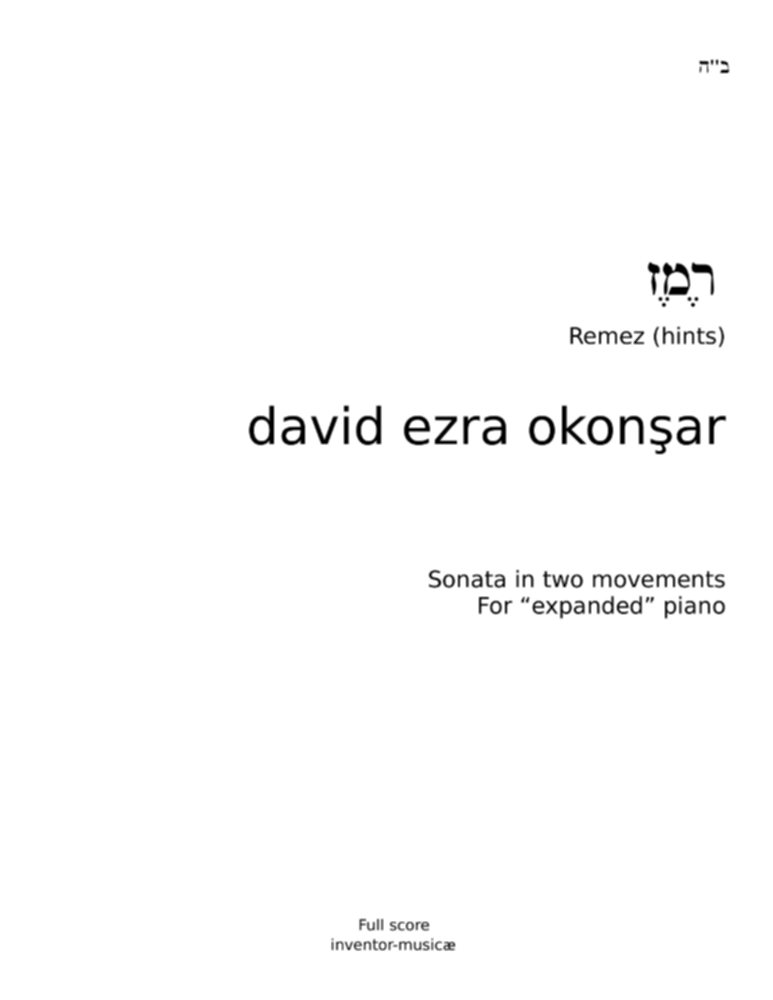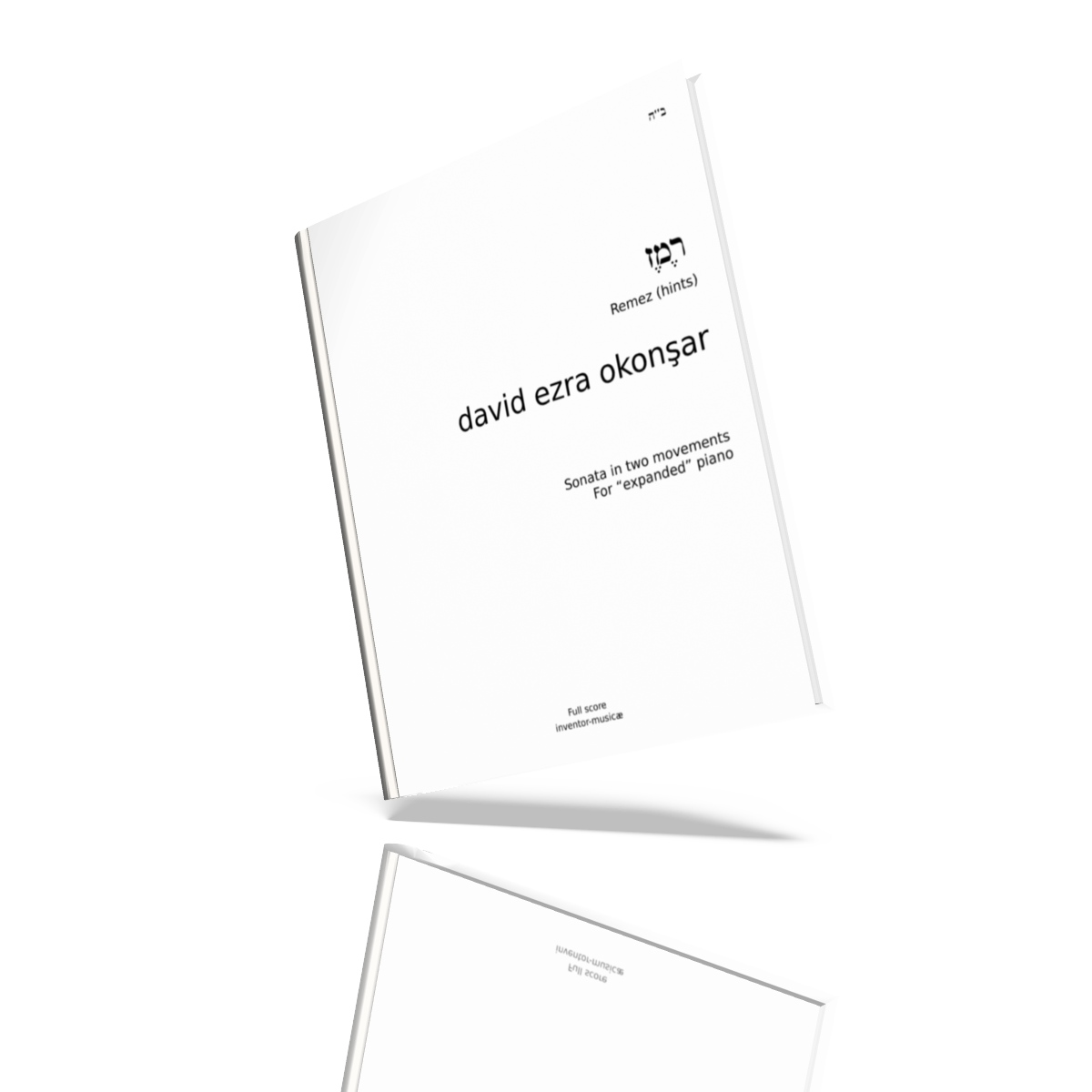
Sonata in Two Movements
for Expanded Piano:
Remez (hints)

|
Remez can be translated as alluded meaning (reading between the lines), in modern Hebrew it means hint. And traditionally, “remez” refers to methods such as “gezera shava” (equivalent language implying equivalent meaning) and “gematria” (word-number values). The various approaches to biblical exegesis, in either rabbinical Judaism or the interpretation of texts of the Torah, has a common name: Pardes sometimes spelled as PaRDes, an acronym of the initials of: Peshat (פְּשָׁט) – “surface” (“straight”) or the literal (direct) meaning; Remez (רֶמֶז) – “hints” or the deep (allegorically: hidden or symbolic) meaning beyond just the literal sense; Derash (דְּרַשׁ) – from Hebrew darash: “inquire” (“seek”) – the comparative meaning, as found through similar occurrences in various contexts; Sod (סוֹד) – “secret” (“mystery”) this is the esoteric or mystical meaning, gained through inspiration or revelation. “Pardes” is said to be the root of the word: paradise. With each step of Pardes, the student is supposed to be guided in the extended meaning of a text. While “peshat” means the plain sense given by the text, “remez” is the allegorical meaning. With “derash”, the student is supposed to embark into metaphorical meaning by comparing the fundamental idea in various and different contextual environments. Finally, only by inspiration, extensive davening (ritual praying) and meditation, the ultimate hidden meaning: “sod” can be eventually, attained. Even though the process is an ordered sequence: peshat - remez - derash and sod, a line of progress starting from the first reading of a biblical text, there is a considerable overlap in those steps. For instance, the straight understanding of a portion (peshat) can be simultaneously influenced both by a mystical interpretation(sod) ; and remez, when a “hint” is determined by comparing a word with other instances of the same word in various contexts. Adepts of the “written-only” Torah, the Karaites aim to adhere to the plain or most obvious meaning (peshat) of the text, yet this is not necessarily the literal meaning, it can rather be, also, the meaning for the ancient Israelites at the time the books of the Torah were first written. By contrast, Rabbinic Judaism relies on the legal rulings of the Sanhedrin as they are codified in the Midrash, Talmud, and other sources to indicate the authentic meaning of the Torah. This oral law employs the methods of remez (implication or clue), drash (interpretation, exegesis), and sod (deep, hidden meaning, identified with the Kabbalah). Both remez and sod, which allowed for greater speculation, became the favorite interpretive methods of the Kabbalists, Jewish mystics who flourished in Europe and Palestine during the Middle Ages and the early modern period. The two movements of this Sonata: “Gezera shava” and “Gematria” adopt the two methods of “remez” for revealing the hints (deep, allegorical, symbolic meanings of texts) and applies them to musical materials, specifically series, rows of musical entities, often rooted in but not exclusively limited to 12-tone techniques. “Gezera shava”, (lit. “identical phraseology”) is a method of biblical exegesis whereby a similar word appearing in two different contexts is used to infer that the details of one context apply to the other. Whether a pair of words is a gezerah shavah or not is determined by rabbinic tradition. Two examples of Gezera shava: The first word of Genesis 1:1 is “Bereishit” (“in the beginning [of]”). According to the Vilna Gaon, all 613 commandments are hinted to in this word. For example, the Vilna Gaon says, the commandment of pidyon haben is hinted via the phrase “Ben Rishon Acharei Shloshim Yom Tifdeh” (“a first son, after 30 days should be redeemed”), and the acronym of the first letters of this phrase is “Breishit”. Another example of how far a “remez-search” can go: In Jewish thought, the Year 6000 idea relates to the six days of the Creation (followed by the Sabbath). 6000 years the world is expected to exist (before a 1000-year messianic era). The first 2000 “hidden” years began at the Creation and lasted until Abraham. The next 2000 years “of revelation” include Israelite Patriarchs, the Giving of the Torah at Sinai, and the two Temples in Jerusalem. Final 2000 years in which we belong, is for the preparation for the Jewish Messiah, and are balanced between Divine concealment and revelation. Genesis 1:1 is said to hint to this idea. The verse contains seven (Hebrew) words, and each of the words except Hashamayim(“Heavens”) contains the letter Aleph (the first letter of the Hebrew alphabet, with a gematria value of 1). The name “Aleph” hints at its etymological variants: aluph (“Chief/Ruler”, representing the one God) and “eleph” (“One Thousand”, representing 1,000 years). Hebrew word roots generally contain three consonant letters. Six out of seven words making the verse Genesis 1:1 containing (except hashamayim), in the first two words Aleph's are positioned as third letters (i.e. concealed God in the first 2,000 years), in the next two words it is positioned as first letters (i.e. revealed God in the middle 2,000 years), and finally in the last two words, Aleph's are positioned as second letters (balance between concealed and revealed God in the last 2,000 years). These two examples show that “gezera shava”, identical phraseology research, is actually far more extensive than a literal “word-search”. This most naturally brings the second main method of what may be called “remez-type-search”: the Gematria. Gematria is word-number values: as each Hebrew letter is also a number, this is simply the sum of numerical values of the letters of a word. Thus giving a hint (Remez) of a probable connection between two different words in two different contexts. An example of gematria is with: or (light) and raz (mystery). Making ground for deep philosophical search on the relationship and the complementarity at the conceptual level of light and mystery. The application areas of those two methods, “identical phraseology” (gezerah shava) and “gematria” are not sharply delimited and often overlap as it is seen in the second example above, where the number value of Aleph is used in a "gezera shava" type of "remez-search". The synthesizer part is to be either performed live or played from pre-recorded media best operated by the pianist. The sound-patch is left to the discretion of the performer. A time-evolving,pitch-shifting, pad-like sound – preset to be preferred. The patch may ideally contain wavetable data derived from piano spectrum. - Sources: wikipedia and chabad.org
|
|||||||||
| cdbabyplayer | |||||||||
|
|||||||||
Video available: on Youtube... direct links at the recording page... |
|||||||||
|





